Inside the Strahov Monastery: Unveiling Prague’s Legacy
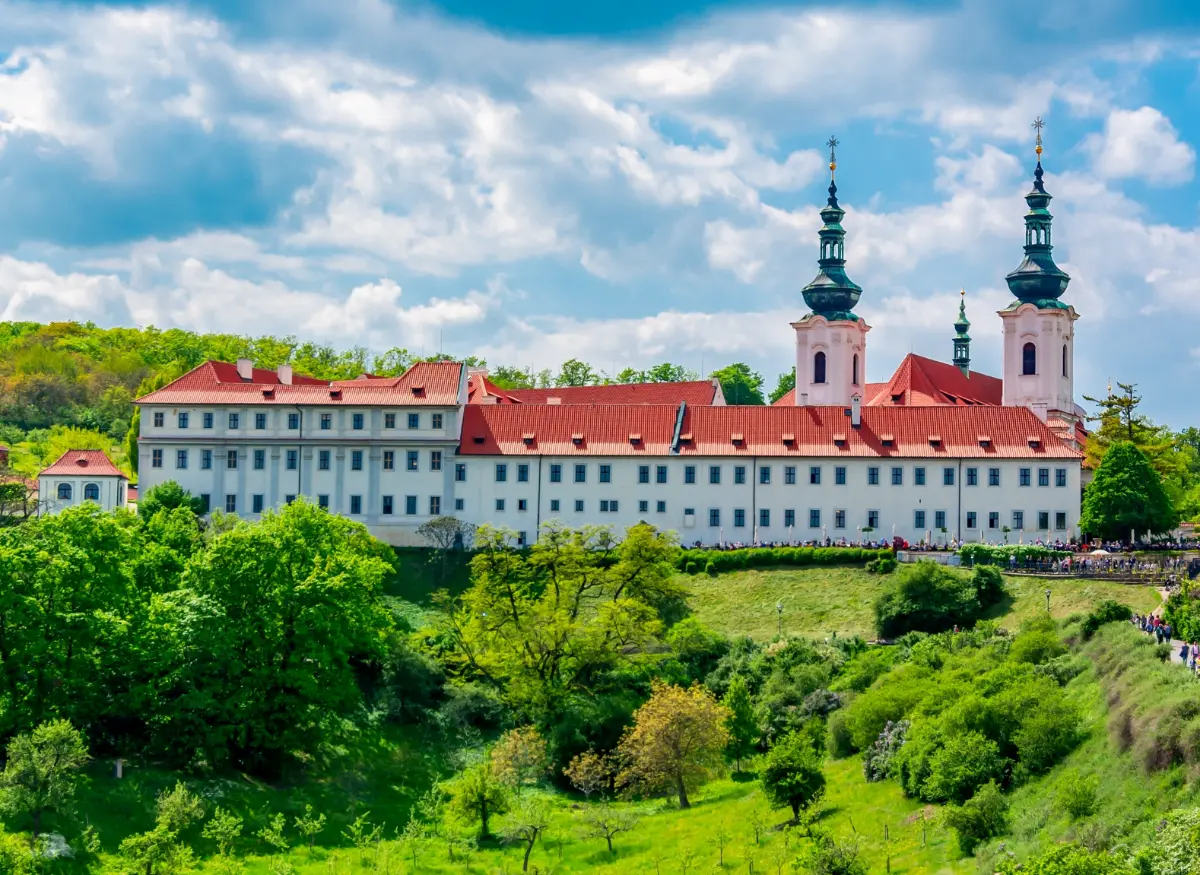
If you plan a trip to Prague, you won’t miss visiting the Strahov Monastery. Founded in 1143 by Jindřich Zdík and Vladislaus II, Duke of Bohemia, it is the largest Premonstratensian monastery in the world and is steeped in history and stunning architecture.
The monastery is located in the Strahov district of Prague and is home to several attractions. The church of the Assumption of the Blessed Virgin Mary is a stunning example of Baroque architecture.
At the same time, the Strahov Library is home to several medieval manuscripts, maps, and globes. The Classical Philosophy Hall is decorated with beautiful frescoes, and the Strahov Gallery boasts one of Central Europe’s most significant collections of Gothic paintings.
In addition to its cultural attractions, the Strahov Monastery is also home to a famous brewery. Visitors can sample traditional Czech beers in the monastery’s beer garden, which offers stunning views of Prague Castle and the old town.
Whether you’re interested in history, architecture, or simply enjoying a good beer, the Strahov Monastery is a must-visit destination in Prague.
Origins of Strahov Monastery
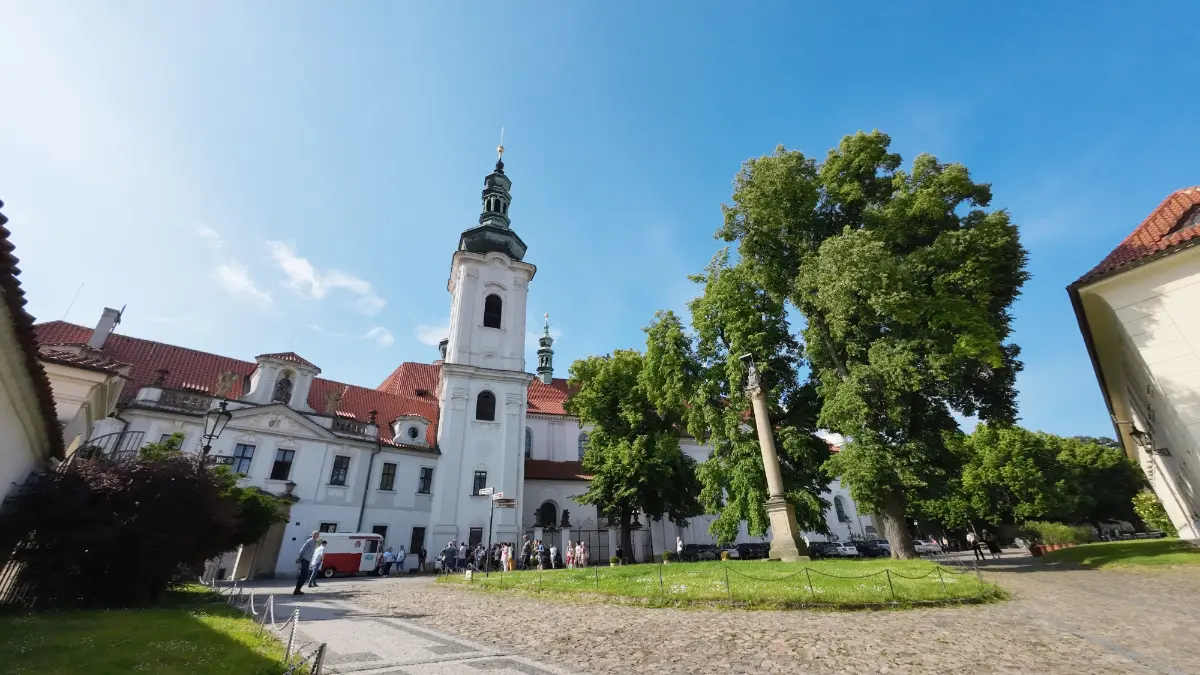
Strahov Monastery in Prague framed by lush greenery, ©Andy / Shutterstock
Strahov Monastery is one of the oldest and most important monasteries in the Czech Republic. Founded in 1143 by Jindřich Zdík, Bishop John of Prague, and Vladislaus II, Duke of Bohemia, the monastery is located in the Strahov district of Prague.
The monastery was originally established as a Premonstratensian abbey and has played a significant role in the history of the Czech Republic.
The founding of the monastery was an important event in Czech history. The Romanesque Basilica was built in the 12th century and was one of Europe’s most extensive Romanesque buildings at the time.
The monastery quickly became a beacon of knowledge and spiritual life, and its library became one of the most important in Europe.
During the Hussite Wars in the 15th century, the monastery was badly damaged, and its library was looted. However, the monastery was later restored and continued to play an important role in the cultural and spiritual life of the Czech Republic.
It was also an important center of learning and scholarship, and many prominent Czech scholars and intellectuals studied and worked there.
Over the centuries, the monastery has been home to many important figures, including Norbert of Xanten, Henry Zdík, and Rudolf II. It has also been the site of many important historical events, including the Velvet Revolution in 1989, which led to the fall of communism in Czechoslovakia.
Today, the Strahov Monastery is a popular tourist destination and a center of cultural and spiritual life in the Czech Republic. Visitors can explore the monastery’s beautiful architecture, including its Romanesque basilica and Baroque library, and learn about its rich history and cultural significance.
Diverse Design Influences
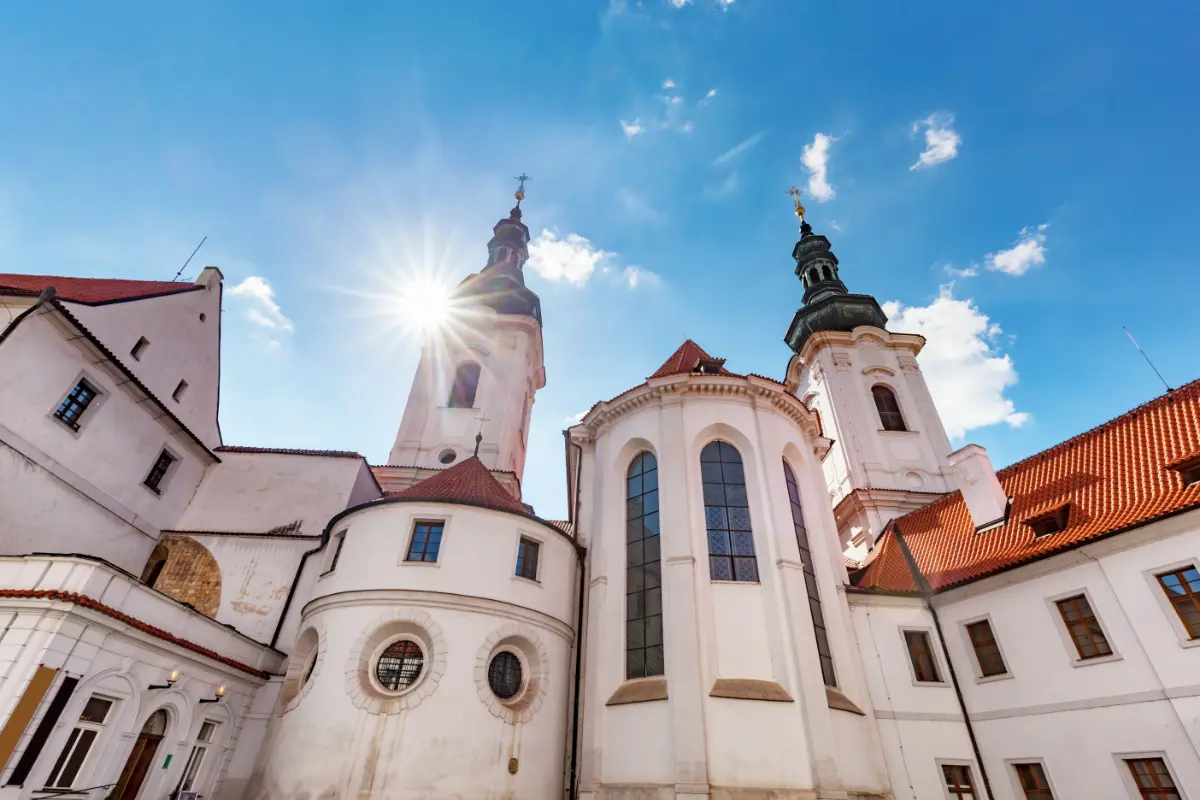
The Basilica of the Assumption of Our Lady in Strahov Monastery, ©Bednarek / Shutterstock
As you explore the Strahov Monastery, you will notice the beautiful blend of architectural styles incorporated into its design. The monastery was initially built in Romanesque style, but after a fire destroyed the complex in 1258, it was rebuilt in the Gothic style.
One of the most prominent features of the Strahov Monastery is the basilica, which boasts a beautifully decorated nave and two white towers topped with golden spires, making it easily noticeable from far away. The basilica is a great example of Gothic architecture, characterized by its pointed arches, ribbed vaults, and flying buttresses.
Another notable feature of the monastery is the new library building, built in the Classical style. This building was designed by architect Jan Ignác Palliardi and is considered an architectural landmark in Prague.
In addition to the Gothic and Classical styles, you will also notice Baroque style elements in the monastery’s design. This style is characterized by its ornate decoration, curved lines, and dramatic lighting. You can see these elements in the monastery’s various chapels and halls.
Overall, the Strahov Monastery is a beautiful example of the various architectural styles that have influenced its design over the centuries.
Churches of Strahov
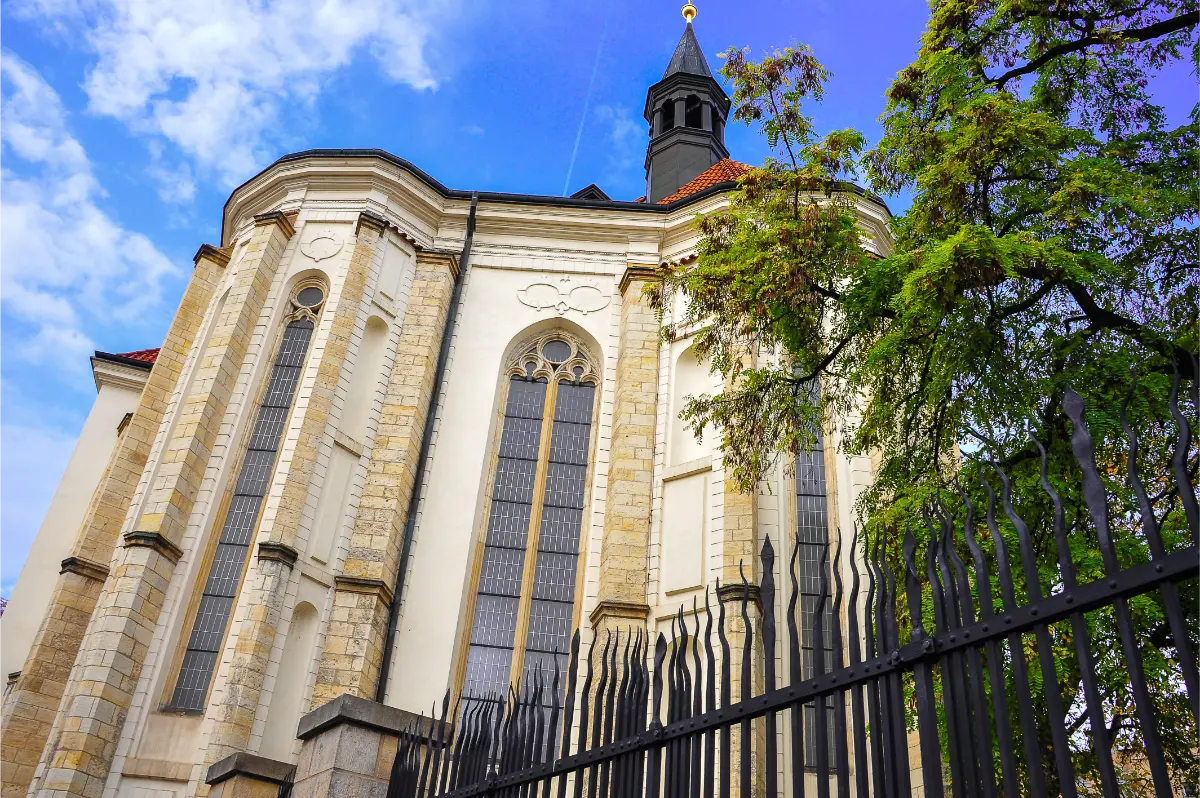
St. Roch Church enclosed by a protective metal fence, ©Linda / Shutterstock
As you enter the Strahov Monastery, you will be awestruck by the magnificent churches in the complex. The churches at the Strahov Monastery are not only places of worship but also serve as architectural marvels worth exploring.
The Church of St. Roch is one of the most prominent churches within the complex. It was built in the 18th century and is dedicated to St. Rochus, the patron saint of plague victims. The church is adorned with intricate frescoes and sculptures, and its architecture perfectly blends Baroque and Rococo styles.
Another notable church within the complex is the Church of the Assumption of Our Lady, also known as the Basilica of the Assumption of Our Lady or the Basilica of the Assumption of the Virgin Mary.
This church was originally constructed as a Romanesque basilica in the 12th century and was later rebuilt in the Baroque style. The church is home to a stunning organ built in the 18th century and considered one of Europe’s best organs.
The Strahov Monastery is also home to the Strahov Library in the Church of the Assumption of Our Lady. The library is home to several medieval manuscripts, maps, and globes, making it a must-visit for history buffs.
Overall, the churches at the Strahov Monastery are a testament to the architectural and artistic prowess of the people who built them. Whether you are a history buff or simply interested in exploring beautiful churches, the Strahov Monastery is worth a visit.
Magnificent Halls
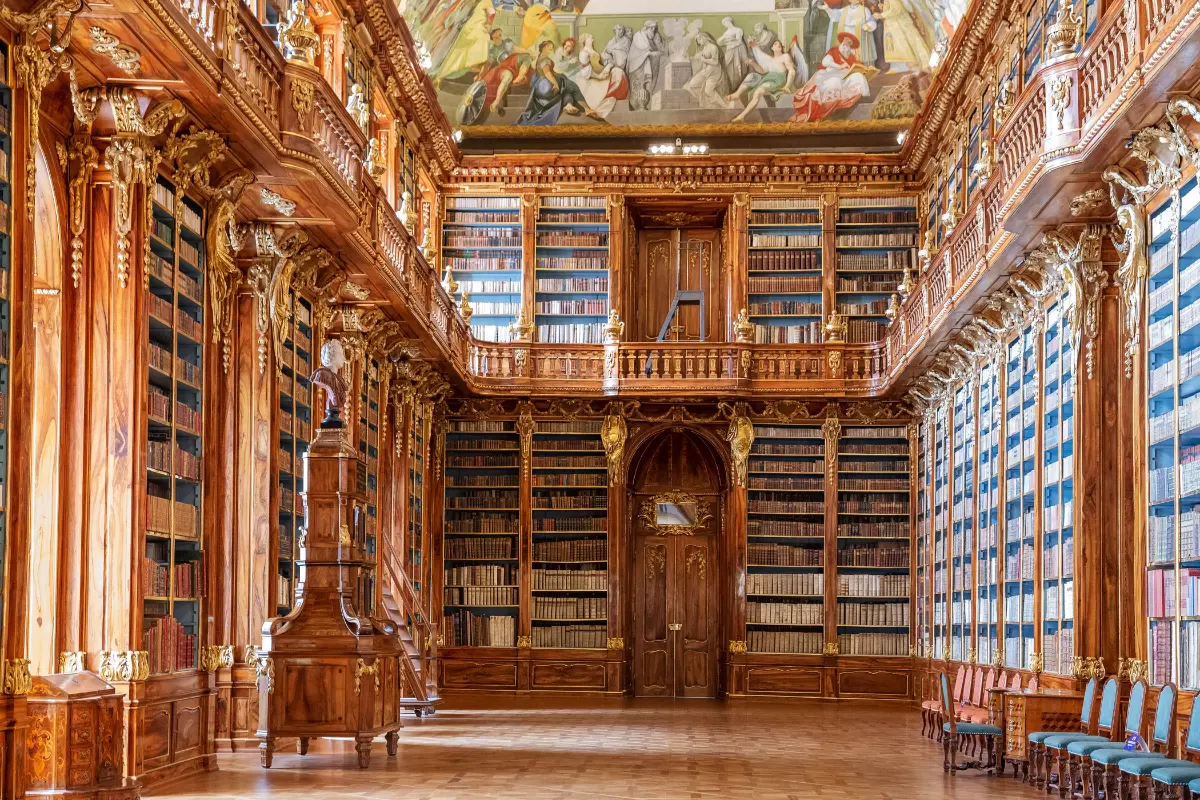
Philosophical Hall at Strahov Monastery, ©Yulia_B/ Shutterstock
As you enter the Strahov Monastery, you will be blown away by the grandeur of the halls. The Theological Hall, built between 1671 and 1674, is the oldest part of the Strahov Library.
It is a Baroque hall that houses about 18,000 books of mostly theological writings, as well as countless editions of the Bible. The hall is beautifully decorated with frescoes and stucco work, which add to its grandeur.
On the other hand, the Philosophical Hall is a more recent addition to the monastery library, built in 1794. It is a stunning example of the Baroque style, with a beautiful ceiling fresco and stucco work.
The Philosophical Hall houses an impressive collection of science books on medicine, law, and alchemy. The hall is also home to a collection of animals, minerals, and mock fruits, which make for a fascinating display.
Both halls are a testament to the Strahov Monastery’s commitment to preserving knowledge and history. The halls are meticulously maintained and provide a glimpse into the past, giving visitors a sense of the importance of knowledge and learning.
In addition to the Theological and Philosophical Halls, the Strahov Monastery has several other halls worth exploring. These halls house various collections, including art, music, and natural history. Each hall is unique and offers visitors a glimpse into a different aspect of the monastery’s rich history.
Overall, the halls of the Strahov Monastery are a must-see for anyone interested in history, art, or literature. The grandeur of the halls and the impressive collections housed within them make for an unforgettable experience.
Inside Strahov’s Library
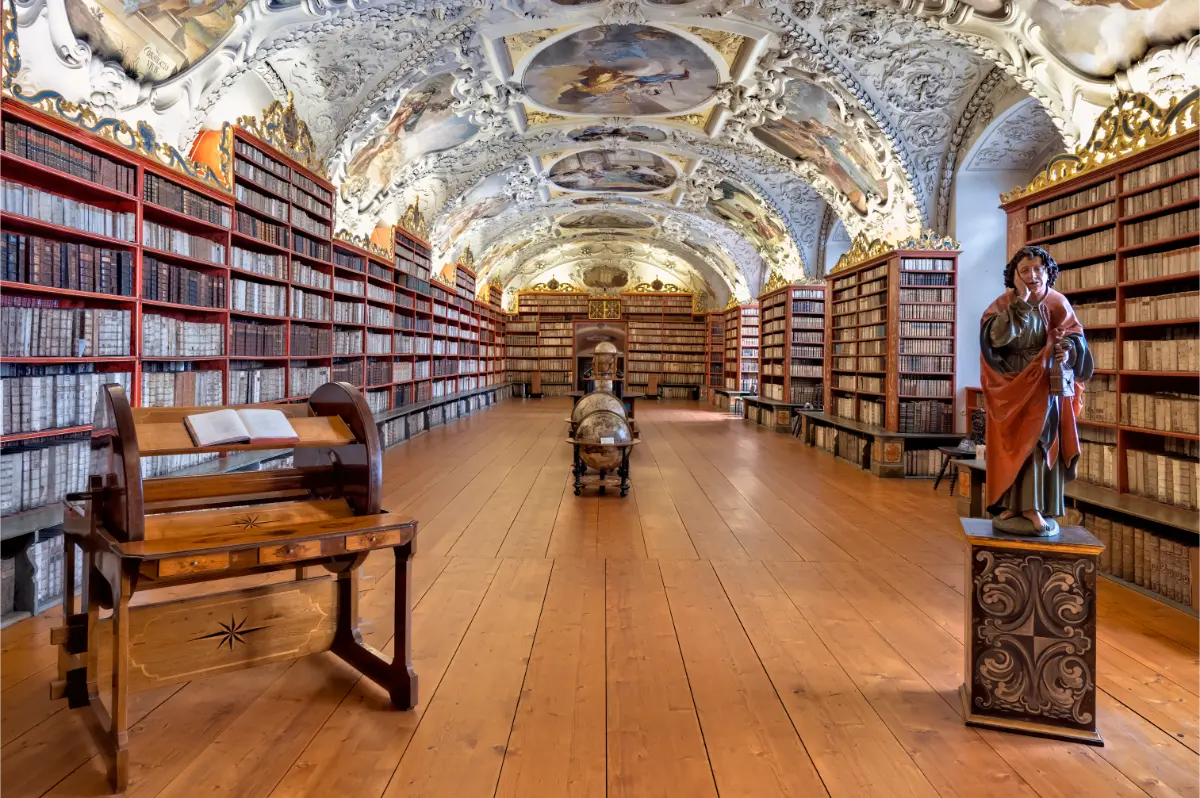
Strahov Monastery’s library, shelves filled with books, ©marcobrivio/ Shutterstock
If you are a bookworm, the Strahov Library is a must-visit place. The Strahov Library is inside the Strahov Monastery. It is one of the world’s most valuable and best-preserved historical libraries, with a collection of approximately 200,000 volumes.
The library is divided into two main halls: the Baroque Theological Hall and the main Classicist vaults of the Philosophical Hall.
The Theological Hall is the oldest part of the library and was established between 1671 and 1674. It houses a collection of theological and philosophical works, including Bibles and other religious texts.
The Philosophical Hall, on the other hand, was established in the 18th century and houses a collection of secular works, including rare volumes and manuscripts. The hall is decorated with intricate frescoes and stucco work, making it one of the most beautiful libraries in the world.
One of the most fascinating things about the Strahov Library is its collection of rare volumes, including a 9th-century illuminated manuscript of the Gospel of John and a 14th-century manuscript of Dante’s Divine Comedy. The library also has a collection of globes, maps, and atlases that date back to the 16th century.
Art at Strahov Monastery
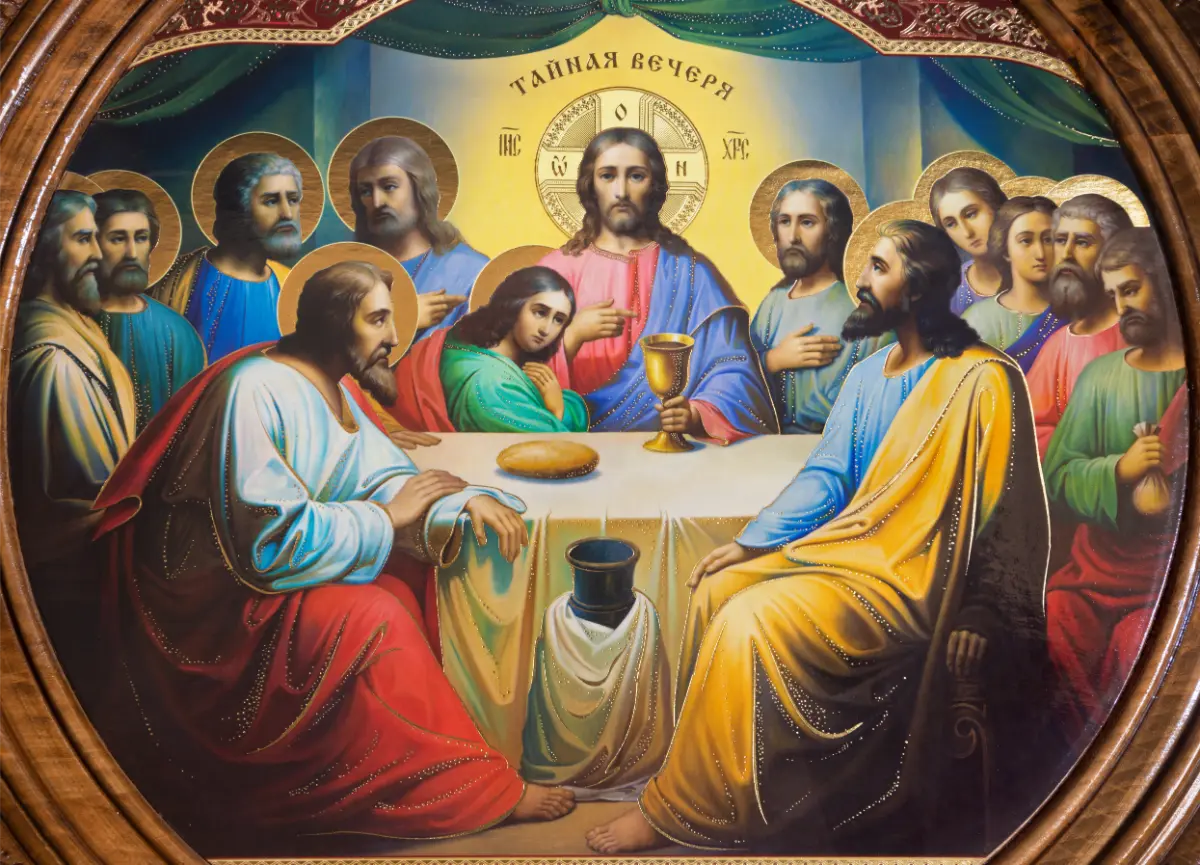
Last Supper masterpiece at Strahov Monastery, ©Sedmakova/ Shutterstock
As you explore the Strahov Monastery, you will undoubtedly come across some of the most impressive art in Prague. The Strahov Picture Gallery is one of the most renowned galleries in the Czech Republic, featuring an extensive collection of European paintings, sculptures, and masterpieces.
The Strahov Picture Gallery has been growing since the 1830s and features a remarkable collection of Central European art.
You will find significant works of art by Anton Maulbertsch, a prominent Austrian painter and fresco artist. His works are characterized by their dramatic use of light, shadow, and vivid colours.
In addition to the Strahov Picture Gallery, the monastery boasts an impressive collection of frescoes and sculptures. The monastery’s interior is adorned with stunning frescoes that depict scenes from the Bible and other religious stories.
One of the most notable frescoes is the “Assumption of the Virgin Mary,” painted by Franz Anton Maulbertsch. This masterpiece is located in the Church of the Assumption of Our Lady and depicts the Virgin Mary being carried up to heaven by angels.
The monastery also features an impressive collection of sculptures, including works by Ignác František Platzer, a prominent Czech sculptor. His sculptures are throughout the monastery, including in the Church of the Assumption of Our Lady.
Overall, the Strahov Monastery is a must-visit destination for art lovers. With its extensive collection of European paintings, sculptures, and frescoes, you are sure to be impressed by the beauty and majesty of this stunning monastery.
Brewing Tradition
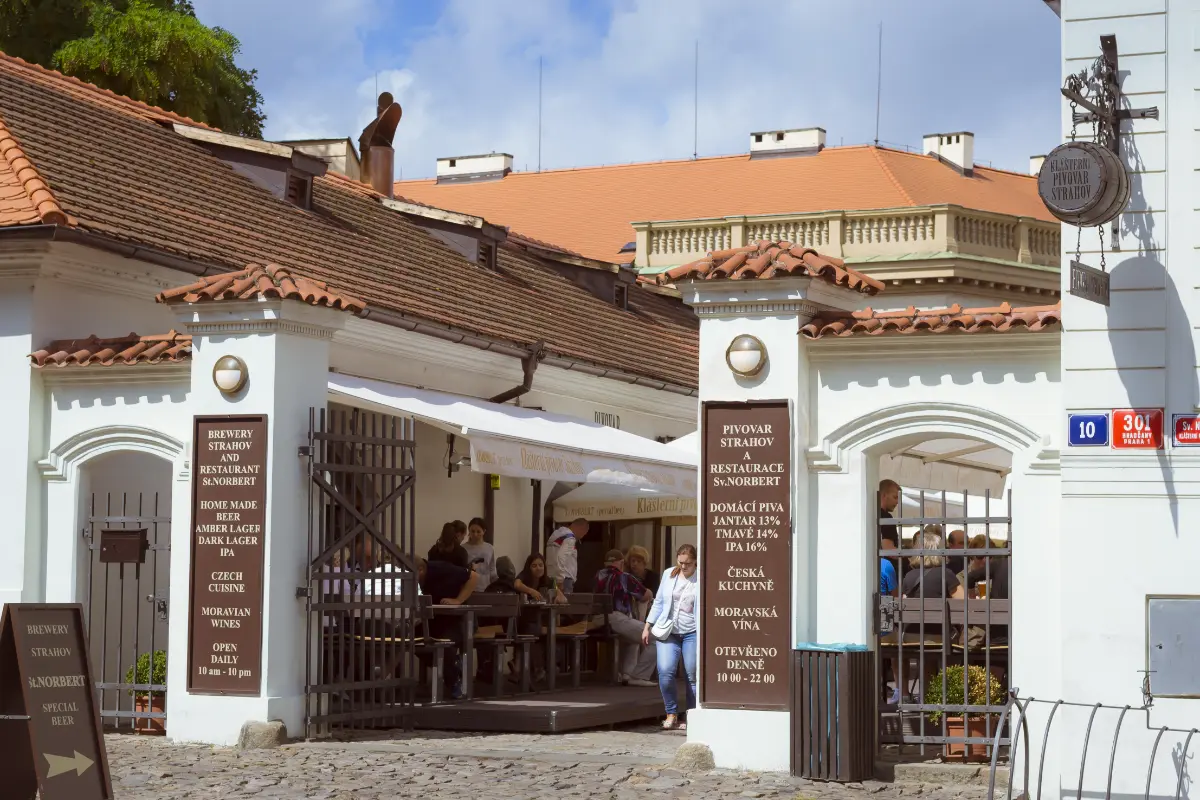
Strahov Monastery’s brewery, a local gem crafting exquisite brews, ©chasdesign/ Shutterstock
Visiting the Strahov Monastery Brewery is a must if you’re a beer fan. This brewery is located within the Strahov Monastery complex, founded in 1142, just a few steps from the iconic Prague Castle.
The Strahov Monastery Brewery is a unique and historic brewery offering on-site beer. The Master brewers have been crafting amazing beer here for over 600 years and are proud to continue the tradition.
The brewery offers a range of beers, including the Saint Norbert beer, a must-try for any beer enthusiast. The beer is brewed using traditional methods and is made with high-quality ingredients, ensuring every sip is a delight to the senses.
The Strahov Monastery Brewery is not just a place to enjoy great beer but also a place to experience the unique ambiance of the monastery.
The brewery is housed in a beautiful, historic building that has been carefully preserved over centuries. The brewery’s distinctive atmosphere offers excellent Czech cuisine to complement the beer.
If you’re planning a trip to Prague, include a visit to the Strahov Monastery Brewery in your itinerary. You won’t be disappointed with the quality of the beer, the ambiance of the brewery, and the unique experience of visiting a historic monastery brewery.
Legacy of the Norbertines
The Strahov Monastery is home to the Premonstratensian Order, also known as the Norbertines. St. Norbert of Xanten founded this order in 1120 in France.
The Premonstratensians are a Roman Catholic religious order of regular canons, meaning they live in a community and follow a monastic way of life while engaging in pastoral work outside the monastery.
The Premonstratensians follow the Rule of St. Augustine, which emphasizes the importance of community life, prayer, and study. They also wear white habits with a black scapular and a white rochet, distinguishing them from other religious orders.
At the Strahov Monastery, the Premonstratensians have a long history of pastoral work, including running a hospital and providing education to the local community.
They also have a rich manuscript illumination and bookbinding tradition, evident in the Strahov Library’s medieval manuscripts, maps, and globes collection.
Overall, the Premonstratensian Order’s presence at the Strahov Monastery has been an important part of the monastery’s history and has contributed to the local community’s spiritual and cultural life.
Monastery Amid Communist Rule
During the communist regime, Strahov Monastery was nationalized, and the communist party seized its property. The monks were expelled from the monastery, and the building was used for various purposes, including as a warehouse for the Czechoslovak Army.
The communist regime viewed religion as a threat to the state and sought to suppress it. In addition to nationalizing religious institutions, the regime also persecuted religious believers, including monks and priests. Many were arrested, imprisoned, or executed.
The monks of Strahov Monastery were not immune to this persecution. Some were arrested and imprisoned, while others were forced to flee the country. The communist regime also confiscated many of the monastery’s valuable artifacts, including its extensive library.
After the fall of the communist regime in 1989, the monastery was returned to the Premonstratensian order. The monks returned and began restoring the monastery to its former glory. Today, the monastery is once again a thriving center of religious and cultural life in Prague.
Essential Visitor’s Guide
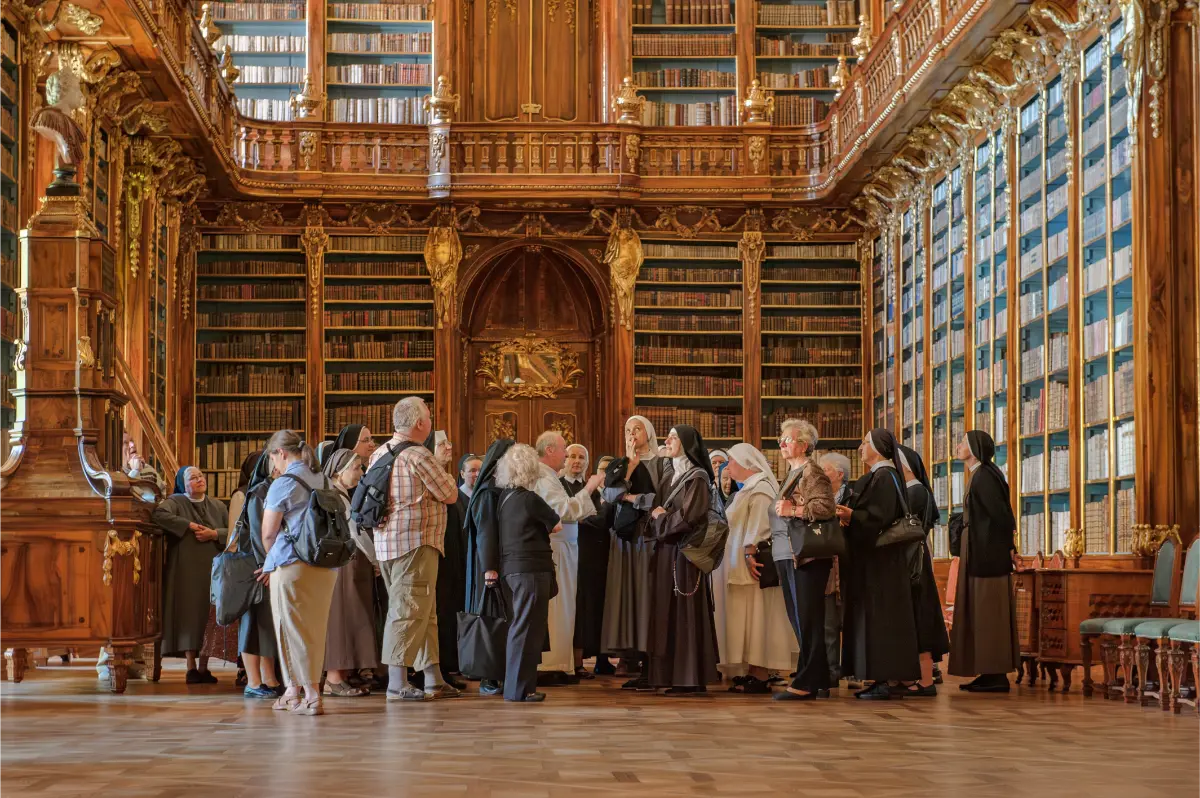
Philosophical Hall at Strahov Monastery, bustling with international visitors, ©Zhou/ Shutterstock
If you plan to visit Strahov Monastery, you should know a few things to make the most of your trip. The monastery is near Prague Castle and can easily be reached by tram or foot. The address is Strahovské nádvoří 1/132, 118 00 Praha 1.
Upon arrival, you will notice the guards at the entrance. You must purchase a ticket to enter the monastery, with an entrance fee. The ticket price may vary depending on the time of year, so it is best to check the web for the most up-to-date information.
Once inside, you can tour the monastery and explore its many attractions. One of the most popular attractions is the Baroque Library, considered one of the world’s most valuable and best-preserved historical libraries. Visitors are allowed to take photos, but you must ask for permission first.
In addition to the library, there are restaurants and a café with a beautiful view of the castle and old town. You can enjoy traditional Czech cuisine while taking in the stunning view.
FAQs
What is the history of the Strahov Monastery?
The Strahov Monastery is a Premonstratensian abbey founded in 1143 by Bishop John of Prague, Jindřich Zdík, and Vladislaus II, Duke of Bohemia.
The monastery has undergone several renovations over the years, and the current building dates back to the 17th and 18th centuries. The Strahov Monastery has played an important role in the religious and cultural history of Prague and the Czech Republic.
What is inside the Strahov Monastery library?
The Strahov Monastery Library is one of the oldest and most important libraries in the Czech Republic. It houses over 200,000 volumes, including rare manuscripts, incunabula, and early printed books.
The library is divided into two sections: the Theological Hall and the Philosophical Hall. The Theological Hall contains religious texts, while the Philosophical Hall contains secular works. The library also has a collection of globes, maps, and astronomical instruments.
Are tickets required to visit the Strahov Monastery?
Yes, tickets are required to visit the Strahov Monastery. The monastery offers several types of tickets, including tickets for the library, the church, and a combined ticket.
The prices of the tickets vary depending on the ticket type and the visitor’s age. It is recommended to purchase tickets in advance to avoid long lines and ensure availability.
How long does it take to tour the Strahov Monastery?
The time it takes to tour the Strahov Monastery depends on the visitor’s interests and the type of ticket purchased. A visit to the library can take anywhere from 30 minutes to several hours, depending on the visitor’s level of interest. A visit to the church typically takes around 30 minutes. A combined ticket for the library and the church can take up to two hours.
What is the significance of the Strahov Monastery church?
The Strahov Monastery church, also known as the Church of the Assumption of the Virgin Mary, is a Baroque-style church built in the 18th century. The church is known for its ornate interior, which includes frescoes, stucco work, and sculptures. The church has played an important role in the religious and cultural history of Prague and the Czech Republic.
Are there tours available for the Strahov Monastery?
Yes, there are tours available for the Strahov Monastery. The monastery offers guided tours of the library and the church and combined tours of both. The tours are led by knowledgeable guides who can provide insight into the history and significance of the monastery. It is recommended to book tours in advance to ensure availability.
Secure your ticket for an unforgettable augmented-reality experience now!









